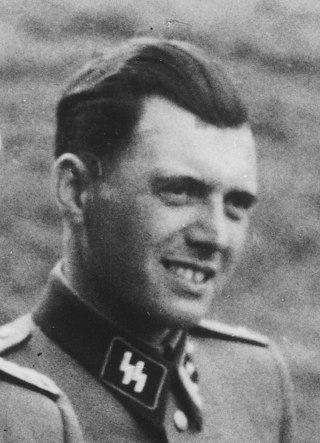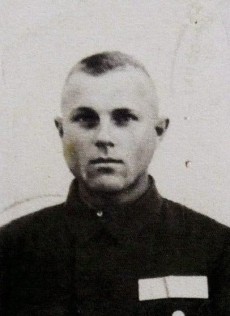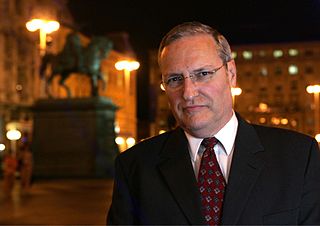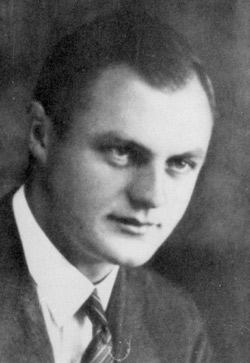Related Research Articles

Josef Rudolf Mengele was a German Schutzstaffel (SS) officer and physician during World War II. Nicknamed the "Angel of Death", he performed deadly experiments on prisoners at the Auschwitz II (Birkenau) concentration camp, where he was a member of the team of doctors who selected victims to be murdered in the gas chambers, and was one of the doctors who administered the gas.

John Demjanjuk was a Ukrainian-American who served as a Trawniki man and Nazi camp guard at Sobibor extermination camp, Majdanek, and Flossenbürg. Demjanjuk became the center of global media attention in the 1980s, when he was tried and convicted in Israel after being misidentified as "Ivan the Terrible", a notoriously cruel watchman at Treblinka extermination camp. In 1993 the verdict was overturned. Shortly before his death, he was tried and convicted in the Federal Republic of Germany as an accessory to the 28,060 murders that occurred during his service at Sobibor.

Alois Brunner was an Austrian officer who held the rank of SS-Hauptsturmführer (captain) during World War II. Brunner played a significant role in the implementation of the Holocaust through rounding up and deporting Jews in occupied Austria, Greece, Macedonia, France, and Slovakia. He was known as Final Solution architect Adolf Eichmann's right-hand man.

The United States Holocaust Memorial Museum (USHMM) is the United States' official memorial to the Holocaust. Adjacent to the National Mall in Washington, D.C., the USHMM provides for the documentation, study, and interpretation of Holocaust history. It is dedicated to helping leaders and citizens of the world confront hatred, prevent genocide, promote human dignity, and strengthen democracy.
The Office of Special Investigations (OSI) of the U.S Justice Department was created in 1979 to identify and expel, from the United States, those who assisted Nazis in persecuting "any person because of race, religion, national origin, or political opinion." This involved gathering, verifying, and presenting in court eyewitness and documentary evidence of decades-old crimes. The evidence was incomplete and scattered around the world. Much of it was then in Eastern Europe, behind the Iron Curtain. Nonetheless, the OSI investigated 1,700 persons suspected of being involved in Nazi war crimes. Over 300 have been prosecuted with at least 100 stripped of their U.S. citizenship and 70 deported, the most recent in 2021. Others have left voluntarily, fled, or have been blocked from entering the United States.

The Holocaust—the murder of about six million Jews by Nazi Germany from 1941 to 1945—is the best-documented genocide in history. Although there is no single document which lists all Jewish victims of Nazi persecution, there is conclusive evidence that about six million were murdered. There is also conclusive evidence that Jews were gassed at Auschwitz-Birkenau, the Operation Reinhard extermination camps, and in gas vans, and that there was a systematic plan by the Nazi leadership to murder them.

The Museum of Jewish Heritage, located in Battery Park City in Manhattan, New York City, is a living memorial to those murdered in the Holocaust. The museum has received more than 2 million visitors since opening in 1997. The mission statement of the museum is "to educate people of all ages and backgrounds about the broad tapestry of Jewish life in the 20th and 21st centuries—before, during, and after the Holocaust."
The Deschênes Commission, officially known as the Commission of Inquiry on War Criminals in Canada, was established by the government of Canada in February 1985 to investigate claims that Canada had become a haven for Nazi war criminals. Headed by retired Quebec Superior Court judge Jules Deschênes, the commission delivered its report in December 1986, after almost two years of hearings.

Simon Wiesenthal was a Jewish Austrian Holocaust survivor, Nazi hunter, and writer. He studied architecture and was living in Lwów at the outbreak of World War II. He survived the Janowska concentration camp, the Kraków-Płaszów concentration camp, the Gross-Rosen concentration camp, a death march to Chemnitz, Buchenwald, and the Mauthausen concentration camp.
John Joseph Loftus, is an American author, former high level U.S. government prosecutor and former Army intelligence officer. He is the president of The Intelligence Summit and of the Florida Holocaust Museum in St. Petersburg.
Operation Last Chance was launched July 2002 by the Simon Wiesenthal Center with its mission statement being to track down ex-Nazis still in hiding. Most of them were nearing the end of their lifetimes, hence the operation's name. Efraim Zuroff is director of the Wiesenthal Center in Jerusalem who serves as the Israeli liaison as well as overseer of this project, the focus of which is an investigation, prosecution, and conviction of the last remaining Nazi war criminals and collaborators. Many have obtained citizenship in Canada and the United States under false pretenses; usually by misrepresentation, omission, or falsification of their criminal past, specifically, war crimes which rose to the level of crimes against humanity.

Efraim Zuroff is an American-born Israeli historian and Nazi hunter who has played a key role in bringing Nazi and fascist war criminals to trial. Zuroff, the director of the Simon Wiesenthal Center office in Jerusalem, is the coordinator of Nazi war crimes research worldwide for the Wiesenthal Center and the author of its annual "Status Report" on the worldwide investigation and prosecution of Nazi war criminals which includes a list of most-wanted Nazi war criminals.

Eduard Wirths was the chief SS doctor (SS-Standortarzt) at the Auschwitz concentration camp from September 1942 to January 1945. Thus, Wirths had formal responsibility for everything undertaken by the nearly twenty SS doctors who worked in the medical sections of Auschwitz between 1942 and 1945.

Eli M. Rosenbaum is an American lawyer and the former Director of the United States Department of Justice, Office of Special Investigations (OSI), which was primarily responsible for identifying, denaturalizing, and deporting Nazi war criminals, from 1994 to 2010, when OSI was merged into the new Human Rights and Special Prosecutions Section. He is now the Director of Human Rights Enforcement Strategy and Policy in that section. He has been termed a "legendary Nazi hunter."

Neal M. Sher was an American lawyer who served as head of the Office of Special Investigations of the United States Department of Justice and as executive director of the American Israel Public Affairs Committee (AIPAC). Since 2002, he was a solo practitioner in New York City and, since 2020, in Southampton, New York, as well.

During the Holocaust, children were especially vulnerable to death under the Nazi regime. An estimated 1.5 million children, nearly all Jewish, were murdered during the Holocaust, either directly by or as a direct consequence of Nazi actions.

Nazi human experimentation was a series of medical experiments on prisoners by Nazi Germany in its concentration camps mainly between 1942 and 1945. There were 15,754 documented victims, of various nationalities and age groups, although the true number is believed to be more extensive. Many survived, with only a quarter of documented victims killed. Survivors generally experienced severe permanent injuries.

Otto Adolf Eichmann was a German-Austrian official of the Nazi Party, an officer of the Schutzstaffel (SS), and one of the major organisers of the Holocaust. He participated in the January 1942 Wannsee Conference, at which the implementation of the genocidal Final Solution to the Jewish Question was planned. Following this, he was tasked by SS-Obergruppenführer Reinhard Heydrich with facilitating and managing the logistics involved in the mass deportation of millions of Jews to Nazi ghettos and Nazi extermination camps across German-occupied Europe. He was captured and detained by the Allies in 1945, but escaped and eventually settled in Argentina. In May 1960, he was tracked down and abducted by Israel's Mossad intelligence agency, and put on trial before the Supreme Court of Israel. The highly publicised Eichmann trial resulted in his conviction in Jerusalem, following which he was executed by hanging in 1962.

The Auschwitz-Birkenau State Museum is a museum on the site of the Auschwitz concentration camp in Oświęcim, Poland.
References
- ↑ "Director of Museum of Jewish Heritage to Step Down". ArtsBeat. Retrieved 2016-01-04.
- ↑ Barron, James (September 27, 2006). "At Long Last, a Shostakovich Premiere". The New York Times . Retrieved 20 November 2009.
- ↑ Kinzer, Stephen (1 April 1994). "Berlin Journal; Torch Is Passed, and the Past Is in German Hands". The New York Times . Retrieved 20 November 2009.
- ↑ Kamen, Al (12 October 1994). "Sen. Byrd: Lord of a Land That Is Not PC". The Washington Post . Retrieved 20 November 2009.
- ↑ "Israeli ex-agent: We allowed Nazi doc to escape". NBC News . 2 September 2008. Retrieved 20 November 2009.
- ↑ "Us Intelligence Paid Nazi For Information". The Prescott Courier. 7 February 1993. Retrieved 20 November 2009.[ permanent dead link ]